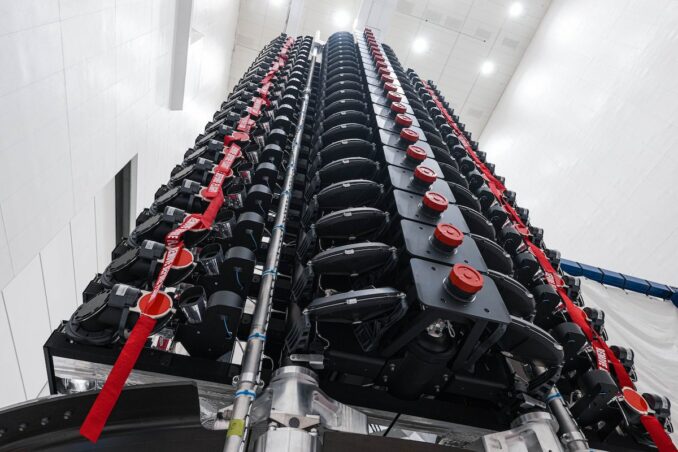Space News & Blog Articles
Live coverage: SpaceX Falcon 9 rocket to launch 22 Starlink satellites from Cape Canaveral
Facing 50-50 weather odds, SpaceX is getting ready for a Falcon 9 launch from Cape Canaveral Wednesday night on its 44th Starlink delivery mission of the year.
Liftoff from Space Launch Complex 40 is scheduled for 10:45 p.m. EDT (0245 UTC), but launch controllers will be keeping a close eye on the weather.
The U.S. Space Force’s 45th Weather Squadron, based at Cape Canaveral, is warning of scattered showers rolling in off the Atlantic and breezy winds. They predict a 50-50 chance of a weather rule violation, with cumulus clouds and liftoff winds being the major concerns.
SpaceX has four back up launch opportunities if needed at 11:38 p.m. EDT (0338 UTC), 12:48 a.m. EDT (0448 UTC), 1:36 a.m. EDT (0536 UTC) and 1:57 a.m. EDT (0557 UTC). There are six more opportunities on Thursday night should the launch slip further.
 File photo of SpaceX’s Starlink V2 Mini satellites stacked for launch inside a payload processing facility at Cape Canaveral. Credit: SpaceX
File photo of SpaceX’s Starlink V2 Mini satellites stacked for launch inside a payload processing facility at Cape Canaveral. Credit: SpaceX
The Falcon 9 is carrying 22 second-generation satellites for SpaceX’s Starlink internet service. The company announced this week that its service was now available across the entire U.S. thank to the four times extra capacity offered by the latest Starink satellite model, known as the V2 Mini. It recently said Starlink now had more than two million subscribers in more than 60 countries.
After lifting off, the Falcon 9 will head south-east, targeting an orbit inclined at 43 degrees to the equator. The first stage booster, making its eighth flight, will separate from the second stage about two and a half minutes into flight before arcing downrange for a landing on the drone ship Just Read the Instructions. The barge will be stationed in the Atlantic ocean east of the Bahamas about 420 miles (675 km) from Cape Canaveral.
The booster, tail-number B1076, first flew on the CRS-26 cargo mission in November 2022. It went on to fly the OneWeb Launch 16 and Intelsat IS-40e mission, and also made four Starlink deliveries. Its most recent flight was on Sept. 9, 2023, making this the fourth fastest turnaround for a Falcon 9 booster between flights.
Two burns of the Falcon 9’s second stage will be required to place the satellites into the required 182 x 176 mile (293 x 284 km) orbit. Separation of the satellite stack is scheduled to occur just over an hour into the flight.
According to statistics compiled by Jonathan McDowell, an astronomer and widely-respected expert on spaceflight activity, SpaceX has launched 5,200 Starlink satellites to date and the number of Starlink satellites remaining in orbit is 4,842.
When you subscribe to the SpaceZE News Feed, we will send you an e-mail when there are new updates on the site so you wouldn't miss them.

